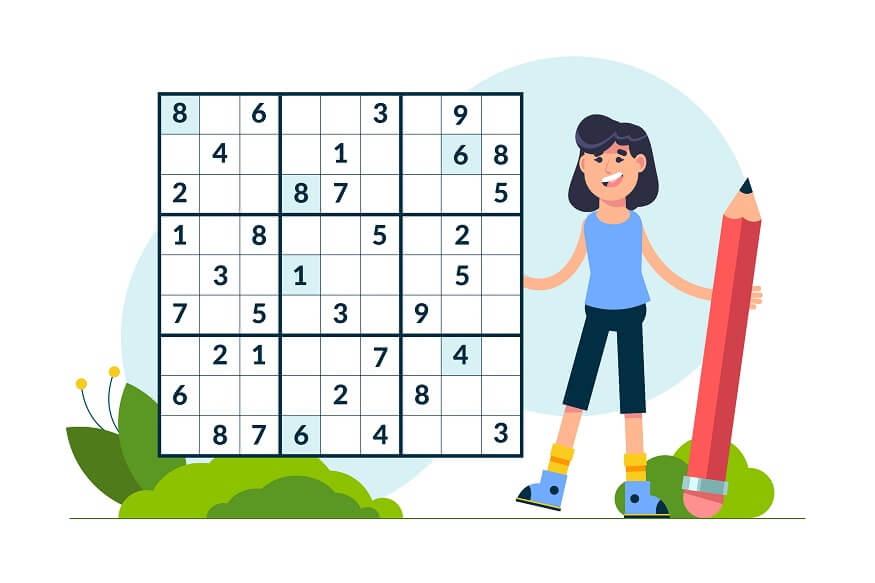Maths is a critical subject for professional growth and career progression. Entry to fields such as engineering, commerce, and management is largely hinged on how good a student is in mathematics. Prominent engineering and management entrance exams such as JEE, CAT, and GMAT have significant weightage for maths. Unfortunately, mathematics is also one of the most feared subjects by students the world over. Stories of students suffering from a phobia towards maths are far too common. A name for this phobia was coined as early as the 1950s, called mathemaphobia. If one has to excel in any of the above fields, mathematics is a subject that cannot be ignored. The question that arises is how do we go about making learning maths fun and engaging for class 4 students. Solving maths puzzles emerges as a plausible solution.
Also Read: Why Studying Maths is Important for Children
Puzzles are an engaging way of learning maths. Instead of solving mathematical equations, such as:
5x + y = 13; y – x = 1; Find the values of x and y
Puzzles make it more meaningful by adding context to it, for example,
Suresh spends 13 Rs to buy 5 paper stickers and 1 laminated sticker. Each laminated sticker is 1 rupee costlier than a paper sticker. Find the per unit cost of paper stickers and laminated stickers.
The dry equation has been converted into a story that looks much more meaningful and much less menacing for class 4 students.
This article presents a variety of such maths puzzles, each followed by useful tips for class 4 students to solve them.
The sum of the ages of 5 children is 100 years. Each of the children is born at an interval of 5 years. What is the age of the youngest child?
Solution:
One of the first steps to solving such problems is to start with the ‘ask’, and create a variable for that ask. In this case, the ‘ask’ is for the age of the youngest child. So, let’s assume the age of the youngest child is ‘x’. Step 2 is to denote the age of each of the children using x.
Age of youngest child = x
Age of the 2nd child = x + 5
Age of the 3rd child = x + 5 + 5
Age of the 4th child = x + 5 + 5 + 5
Age of the 5th child = x + 5 + 5 + 5 + 5
The sum of their ages is 100 years:
x + (x+5) + (x+5+5) + (x+5+5+5) + (x+5+5+5+5) = 100
Or, 5x + 50 = 100
Or, 5x = 50
Or x = 10.
Answer: The age of the youngest child is 10 years.
Also Read: Top 10 Ways to Utilise Maths Formulas in Day-to-Day Life
What should be the next number in the given series: 2, 5, 10, 17, 26, ___?
In such types of puzzles, the key is to identify the patterns. In this case, the number in nth position is (n2 + 1).
The series can be represented as:
(12 + 1), (22 + 1), (32 + 1), (42 + 1), (52 + 1), (62 + 1), ..
This means that the missing number is 37.
Usually, in such puzzles, there is some relation of the number at the nth position with the value of the number n.
Ramesh is driving his bike at the speed of 50 km per hour. How much distance will he cover in 2.5 hours?
These are simple time and distance problems wherein the application of multiplication and division can be tested. 50 km in 1 hour, so in 2.5 hours Ramesh will cover 50*2.5 = 125 km.
Another variation of this could be,
Ramesh is driving his bike at the speed of 50 km per hour. How much time will it take to reach home if his home is 125 km away?
50 km in one hour, implies 125 km in 125/50 = 2.5 hours.
Jimmy had some oranges. He sold 20% of his oranges, and he still has 200 oranges left. How many apples did he sell?
Jimmy sold 20% of oranges, which means he has 80% of his oranges left, which is 200. So if 80% is 200, 100% would be 200/0.80 =250. He had 250 oranges, he sold 20% which means he sold 0.2*250 = 50 oranges.
A father is twice the age of his son. 5 years ago the father was three times the age of his son. How old is the father and the son today?
Let’s assume the age of the son is x today. Age of father today = 2x
Age of the son 5 years ago = x-5, and of father 5 years ago = 2x-5
2x-5 = 3*(x-5); or 2x – 5 = 3x – 15, or x = 10. The age of the son today is 10 years and the age of the father is 2*10 = 20 years.
The difference between a two-digit number and the number formed after interchanging the digits is 27. The sum of the two digits of the number is 11. Find the number.
For such questions, the 2-digit number can be assumed to be 10x+y, where x and y are the two digits. Interchanging the digit, the number becomes 10y+x
As per the first condition, (10x+y) -(10y+x)=27; or 9x-9y=27; dividing both sides by 9, x-y=3
We also know that x+y=11
Adding the two equations, x-y + x+y=3+11; or, 2x=14; implies, x=7; thus, y = 4. The two-digit number thus is 74.
Also Read: 15 Hands- On Math Activities for Preschoolers
Jan 1, 2006, was a Sunday. What day of the week is Jan 1, 2010?
Implies, 31st Dec 2005 was a Saturday. Each year has 52 complete weeks, which implies 52*7=364 days accounted for, with 1 extra day. This means the day will advance by 1 every year except the leap year 2008 where it will advance by 2 weekdays.
So, 1 Jan 2006 is Sunday, 1st Jan 2007 would be Monday, 1st Jan 2008 would be Tuesday, 1st Jan 2009 would be Thursday (1 extra day for leap year), and 1st Jan 2010 would be Friday.
Students at EuroSchool are exposed to more such fun and engaging mathematical puzzles. This makes EuroSchool students comfortable with maths which holds them in good stead for their future career progression and professional prospects.











